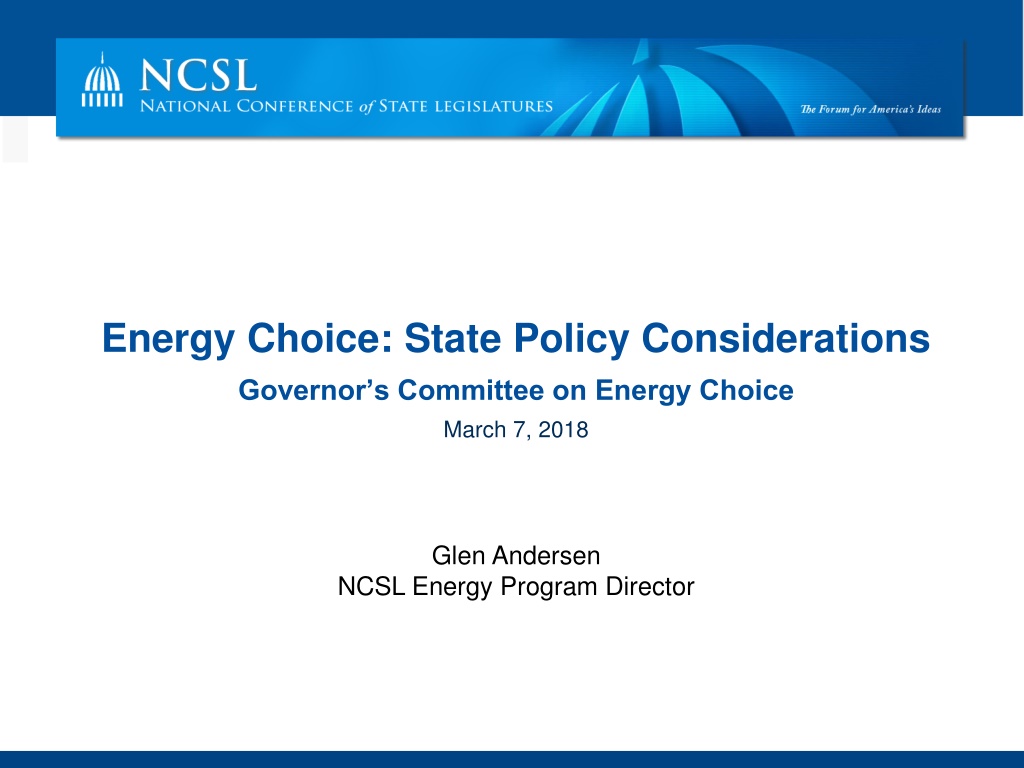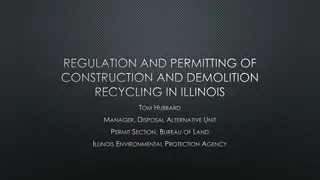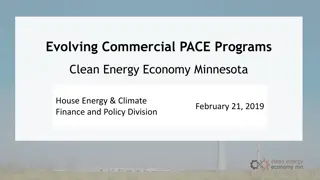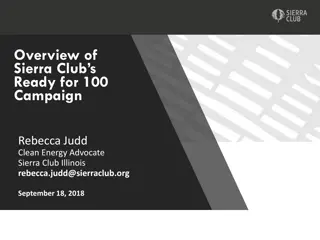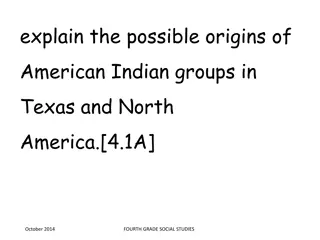Understanding Energy Choice in Illinois and Texas: Policy Considerations and Market Dynamics
Explore the Energy Choice policies in Illinois and Texas through key legislation such as the Illinois Customer Choice Act and Texas Senate Bill 7. Learn about the impact on retail rates, market participants, and customer switching behaviors. Gain insights into the evolution of retail choice in these states and the role of regulatory frameworks in shaping the energy market landscape.
Download Presentation

Please find below an Image/Link to download the presentation.
The content on the website is provided AS IS for your information and personal use only. It may not be sold, licensed, or shared on other websites without obtaining consent from the author. Download presentation by click this link. If you encounter any issues during the download, it is possible that the publisher has removed the file from their server.
E N D
Presentation Transcript
Energy Choice: State Policy Considerations Governor s Committee on Energy Choice March 7, 2018 Glen Andersen NCSL Energy Program Director
Status of Retail Choice Source: Energy Information Administration
Illinois Customer Choice Act (1997) Reduced residential rates by approximately 20 percent of 1997 levels and froze them for a decade Retail choice was phased in from 1999 to 2002 Amendments between 2006 and 2007 Offered $1 billion in rate relief Created Office of Retail Market Development within the Illinois Commerce Commission Allowed municipal corporate authorities to aggregate residential and small commercial retail electric loads in their jurisdiction and solicit bids for service
Illinois Amendments between 2006 and 2007 Illinois Power Agency Created in 2007 Default suppliers (ComEd and Ameren) use the Agency to procure supply on the market. Submit plans to PUC for rate cases. Utility assumed payment collection and provided consolidated billing (line charges and supplier bill), then pays supplier. Alternative suppliers can t turn of service but utility can. Implementation completed around 2012, and suppliers entered the market
Illinois Between 56 and 67 percent of residential customers in Ameren zones have alternate suppliers while the rate is 35 percent in ComEd 2012-14 alternative suppliers were saving $139, but paying $87 more by 2017
Illinois By 2013, residential switching reached 25 percent By 2015, 70% residential market in ComEd switched, but decreased to 35% by 2017 Slightly more than half were with municipal aggregators
Texas Senate Bill 7 (1999) Designated a Provider of Last Resort (incumbent utility) Requires customers to start with an affiliated retailer no default service T&D provider still regulated Established an effective date of January 1, 2002 Certification process for Retail Electricity Providers Established Price to Beat for 2002-2007 Prevents incumbent providers from undercutting new entrants prices Price floor for incumbents
Texas Senate Bill 7 Allowed munis and co-ops to opt into retail choice (just one co-op so far) Mandated Energy Efficiency Implemented by Transmission Distribution Utilities Funded through surcharge on electric bills Reduce customers energy consumption as well as electric peak demand Legislation sets EM&V requirements and goals In 2016, 109 retail providers were operating in ERCOT, providing 440 total unique products, 97 of which provided 100% renewable sources
Texas Texas Power To Choose Website Providers will try to game search results and try to create plans that exploit search parameters Electricity facts one pager summarizes offer is required to be posted. Filters minimum usage fees (legislation to ban them failed) Shows providers complaint records Even with requirements, can be hard to compare plans: i.e. some charge is 1.5 cents per kwh up to 1,000 kwh and 8.8 cents for more than 1,000
Texas Rates 92% of Residential and 98% of non-residential customers have switched providers since the market opened in 2002 Average across all available plans in the competitive market was 9.8 cents per kWh in 2016 Fixed and variable rates lower than nationwide average of 13.45 cents 2017 Report to the 85th Texas Legislature: Scope of Competition in Electric Markets in Texas
Pennsylvania Electricity Generation Customer Choice and Competition Act (1996) Legislature worked in close collaboration with the PUC in drafting legislation Default Service Provider regulated and must pass through cost of generation can t lowball or overcharge Rate caps were removed by 2011, retailers started entering the market in 2010 One year pilot phase-in period for 5% of customer base to identify and sort out challenges Legislation to require choosing a retail provider failed in 2013 after polar vortex rate spikes
Pennsylvania Key Reforms Quick Switching allow customers to quickly switch back to default provider within 3 days in PA Marketing regulations required suppliers to verify enrollment through 3rd party to minimize slamming Disclosure regulations craft rules that help customer navigate new offerings but don t hinder innovation Electronic Data Exchange Working Group data exchange between utilities and suppliers is key to a functioning market
Pennsylvania Outcomes Between 1996 and 2011, rate caps were removed in individual utility regions one after another Switching rates from January 2018 Residential 33% Commercial 85% Industrial 97% Low Income Support of EE for lower incomes Bills capped to percentage of income 70% of the low income customers who switched from default service paid more (Kleinman Center for Energy Policy - University of PA)
Pennsylvania Rate Impacts From 2011 to 2014, Commercial and Industrial rates generally lower than default service rates 5 to 56% lower than 1996 Residential rate generally higher 2 to 41% lower than in 1996 Distribution prices Down for commercial and industrial sector Up for residential sector https://kleinmanenergy.upenn.edu/paper/electricity-competition
Montana Montana Electric Utility Industry Restructuring and Consumer Choice Act (1997) California crisis introduced major volatility into the market Couldn t insulate itself from regional market fluctuations Price caps expired after 2003 State responded by passing nine bills in 2001 Waived taxes and other incentives for new generation in the state Voters rejected major bill to save the industry in a 2002 referendum, which ended restructuring efforts Reregulated in 2007 with the Electric Utility Reintegration Act
Rate Impacts in Other States The Maine Public Utilities Commission found that, from 2014 to 2016, competitive electricity provider customers paid $77.7 million more than what they would have paid for standard offer service In January 2013, New York s attorney general found that 91.5 percent of upstate low-income consumers who d switched were paying higher rates than if they d stuck with the default provider utility
Issue to Consider Providing an accurate, informative, and fair presentation of offers; setting parameters Ensuring customers can easily distinguish differences in cost, services and benefits Balance tension between distorting market and provide enough information, but not too much Requirements for all electricity companies to advertise their plans with the same pricing details (kwh charges plus T&D) Minimum usage rates discourage conservation, hurt low-income consumers and increase T&D costs; effect energy efficiency Address minimum fees, low intro rates, early termination charges, contract length, and other details PA website requires all disclosures and 1 page contract summary while new rulemaking addresses introductory pricing
Issue to Consider Switching Ensure customers receive clear signals when switching In Texas, ERCOT sends postcard notice before switching In Pennsylvania, third party verification of switching Provide significant penalties for slamming and cramming Set switch hold policy Reporting Biennial report to legislature in TX: Scope of Competition in Electric Markets No reporting required in PA Legislative reports required in IL
Conclusion Restructuring of the electric utility industry is not for the impatient, the weak-kneed, or the fainthearted. - Montana Electrical Utility Industry Restructuring Transition Advisory Committee Report to the Governor and Legislature, December 2002.
Contact Information Glen Andersen, Energy Program Director Phone: 303-856-1341 glen.andersen@ncsl.org Additional Resources NCSL Energy and Environment Database NCSL Energy Program
